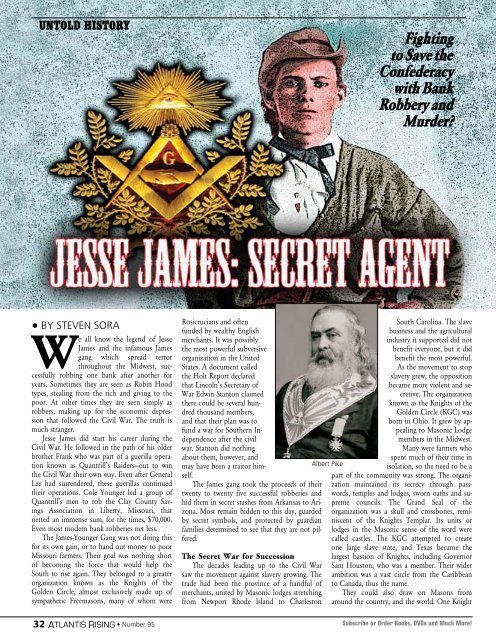Do We Know What We Think We Know About ... - TheUFOStore.com
Do We Know What We Think We Know About ... - TheUFOStore.com
Do We Know What We Think We Know About ... - TheUFOStore.com
You also want an ePaper? Increase the reach of your titles
YUMPU automatically turns print PDFs into web optimized ePapers that Google loves.
UNTOLD HISTORY<br />
• BY STEVEN SORA<br />
<strong>We</strong> all know the legend of Jesse<br />
James and the infamous James<br />
gang which spread terror<br />
throughout the Midwest, successfully<br />
robbing one bank after another for<br />
years. Sometimes they are seen as Robin Hood<br />
types, stealing from the rich and giving to the<br />
poor. At other times they are seen simply as<br />
robbers, making up for the economic depression<br />
that followed the Civil War. The truth is<br />
much stranger.<br />
Jesse James did start his career during the<br />
Civil War. He followed in the path of his older<br />
brother Frank who was part of a guerilla operation<br />
known as Quantrill’s Raiders—out to win<br />
the Civil War their own way. Even after General<br />
Lee had surrendered, these guerillas continued<br />
their operations. Cole Younger led a group of<br />
Quantrill’s men to rob the Clay County Savings<br />
Association in Liberty, Missouri, that<br />
netted an immense sum, for the times, $70,000.<br />
Even most modern bank robberies net less.<br />
The James-Younger Gang was not doing this<br />
for its own gain, or to hand out money to poor<br />
Missouri farmers. Their goal was nothing short<br />
of be<strong>com</strong>ing the force that would help the<br />
South to rise again. They belonged to a greater<br />
organization known as the Knights of the<br />
Golden Circle, almost exclusively made up of<br />
sympathetic Freemasons, many of whom were<br />
32 ATLANTIS RISING • Number 95<br />
Rosicrucians and often<br />
funded by wealthy English<br />
merchants. It was possibly<br />
the most powerful subversive<br />
organization in the United<br />
States. A document called<br />
the Holt Report declared<br />
that Lincoln’s Secretary of<br />
War Edwin Stanton claimed<br />
there could be several hundred<br />
thousand members,<br />
and that their plan was to<br />
fund a war for Southern Independence<br />
after the civil<br />
war. Stanton did nothing<br />
about them, however, and<br />
may have been a traitor himself.<br />
The James gang took the proceeds of their<br />
twenty to twenty five successful robberies and<br />
hid them in secret stashes from Arkansas to Arizona.<br />
Most remain hidden to this day, guarded<br />
by secret symbols, and protected by guardian<br />
families determined to see that they are not pilfered.<br />
The Secret War for Succession<br />
The decades leading up to the Civil War<br />
saw the movement against slavery growing. The<br />
trade had been the province of a handful of<br />
merchants, united by Masonic lodges stretching<br />
from Newport Rhode Island to Charleston<br />
Albert Pike<br />
Fighting<br />
to to Save Save the the<br />
Confederacy<br />
with with Bank Bank<br />
Robbery Robbery and and<br />
Murder?<br />
South Carolina. The slave<br />
business and the agricultural<br />
industry it supported did not<br />
benefit everyone, but it did<br />
benefit the most powerful.<br />
As the movement to stop<br />
slavery grew, the opposition<br />
became more violent and secretive.<br />
The organization<br />
known as the Knights of the<br />
Golden Circle (KGC) was<br />
born in Ohio. It grew by appealing<br />
to Masonic Lodge<br />
members in the Midwest.<br />
Many were farmers who<br />
spent much of their time in<br />
isolation, so the need to be a<br />
part of the <strong>com</strong>munity was strong. The organization<br />
maintained its secrecy through passwords,<br />
temples and lodges, sworn oaths and supreme<br />
councils. The Grand Seal of the<br />
organization was a skull and crossbones, reminiscent<br />
of the Knights Templar. Its units or<br />
lodges in the Masonic sense of the word were<br />
called castles. The KGC attempted to create<br />
one large slave state, and Texas became the<br />
largest bastion of Knights, including Governor<br />
Sam Houston, who was a member. Their wider<br />
ambition was a vast circle from the Caribbean<br />
to Canada, thus the name.<br />
They could also draw on Masons from<br />
around the country, and the world. One Knight<br />
Subscribe or Order Books, DVDs and Much More!


